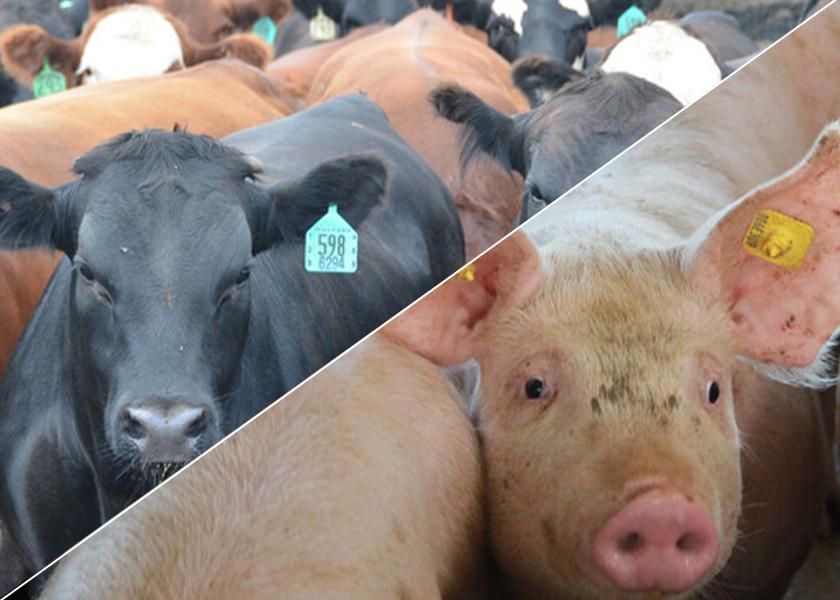Livestock Analysis | July 15, 2022

Hogs
Price action: July lean hog futures went off the board today at $114.90, down 2 1/2 cents. August lean hog futures closed the day Friday up 25 cents at $109.825 and for the week rose 65 cents.
5-day outlook: It was not a bad week for the lean hog futures market bulls, as the chart-based traders see that this week a bullish pennant pattern on the daily chart for August futures formed and may produce technical buying early next week. Cash market fundamentals are also solid late this week, to encourage the lean hog futures bulls heading into next week. The pork cutout value at noon today rose a strong $4.50 at $123.01, led by gains in loins, ribs and hams. Movement was 107.18 loads. The preliminary CME cash index quote for Thursday’s is calculated at $114.15, up 76 cents from Wednesday’s official quote at $113.39. The five-day national direct rolling average cash hog price today was quoted at $118.95.
30-day outlook: Seasonally, daily hog slaughter levels will likely start to rise in the coming weeks and stay that way into the end of the year. That could put a near-term top in for the cash hog market soon. However, demand for bacon just ahead of the BLT season should keep a floor under the cash and futures markets. Still-high beef prices at the meat counter, amid increasing worries about a U.S. recession, should also steer consumers more to the cheaper pork cuts at the meat counter.
90-day outlook: U.S. weekly pork exports sales this week were down 42 percent from the previous week and 37 percent from the 4-week average. A strong U.S. dollar that saw the dollar index hit a 20-year high this week may be crimping foreign demand for U.S. pork. Also, China has seen a notable reduction in its U.S. pork purchases in recent weeks. The U.S. pork export numbers will have to improve if cash and futures prices are to hold present levels, or advance.
What to do: Be prepared to extend feed coverage when market bottoms are in place.
Hedgers: Carry all risk in the cash market for now
Feed needs: You are hand-to-mouth on corn-for-feed and soybean meal needs.
Cattle
Price action: Cash cattle slippage seemed to undermine futures again Friday, with August live cattle ending the week at $134.925, down 47.5 cents on the day, but up 97.5 cents on the week. August feeder futures also fell, dropping $2.55 to $176.35 at Friday’s close. However, that marked a weekly increase of $4.625.
5-day outlook: Cash prices continued slipping Thursday, with the Monday-Thursday average for the five direct-market areas dipping to $144.45, down considerably from the week-prior figure at $147.07. It was rather surprising to see prices decline more substantially in the north than in the south, since northern feedlot supplies have consistently proven much tighter in recent weeks. One has to suspect packers have recently been and continue to be much more aggressive in their southern purchases than in the north, simply due to the huge price disparity between the regions. That may continue in the short run, thereby ending the recent bifurcation, but we don’t see front-end supplies increasing substantially, especially given the cattle market’s history of seasonally declining feedlot and slaughter numbers in late summer and fall. Still, more seasonal weakness seems likely next week.
30-day outlook: Red meat demand has apparently proven much stronger in recent weeks than many expected. For example, after slipping Thursday, choice beef cutout rebounded 82 cents to $268.57 at midsession Friday. That’s about $5.00 over the July 1 quote. We think that firmness will persist in the coming weeks, due in part to anticipation of seasonally diminishing beef production as summer and fall pass. Still, the traditional summer-demand doldrums often seen during summer could keep a lid on rally attempts in the cash and futures markets.
90-day outlook: Beef demand should improve as Labor Day looms, although the usual consumer demand shift away from steaks and toward roasts amidst cooling weather tends to undercut carcass values. Conversely, cattle slaughter typically declines from summer highs into late autumn. These forces often power a seasonal cattle rally from mid-to-late summer into fall, winter and eventually into early the following spring. We see little reason to expect a change in the coming months, especially if next week’s USDA Cattle report indicates U.S. ranchers continue thinning their herds.
What to do: Be prepared to extend feed coverage when market bottoms are in place.
Hedgers: Carry all risk in the cash market for now.
Feed needs: You are hand-to-mouth on corn-for-feed and soybean meal needs.






